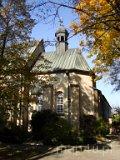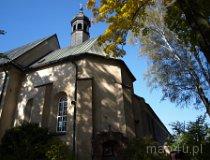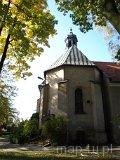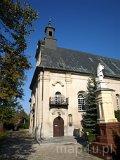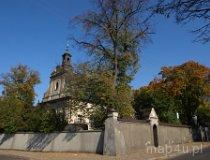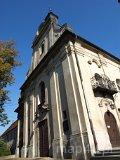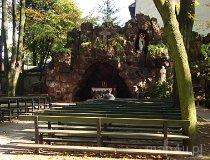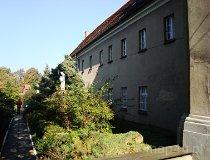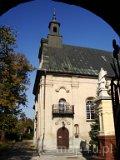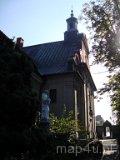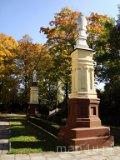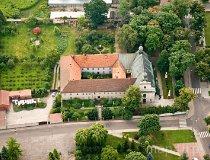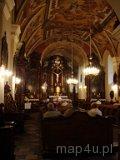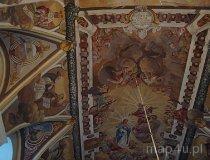Zespół klasztorny Reformatów w Wieluniu
Description
It is a baroque oriented masonry temple. The church interior is as impressive as its outside appearance and historical elements that can be found inside the monastery. The church interior has one rectangular nave and a narrower semi-circular presbytery (outside it is polygonal). The parvis has a groin vault and the rest of the building has a barrel vault with lunettes. The main altar and four side altars as well as the confessionals, benches and other elements from the second half of the 18th century are made of oak wood. In the nave there are buttresses of the Twelve Apostles and numerous masonry epitaphs. In 1683 the vault gained magnificent polychromes depicting the Immaculate Conception. They were re-painted twice in the second half of the 18th century and once in the 20th century. The presbytery is decorated with polychromes from the interwar period (painted to celebrate the 300th anniversary of the temple) depicting the Transfiguration of Jesus. The floor was made from marble in 1765. Under the floor there is the 18th century vault where the graves of late monks are situated. In the church there is also a baroque confessional, a black marble lavabo and a prayer kneeler with a crucifix.
The sculpture of the Christ on Cross surrounded by the sculpters of the saints and Our Lady decorate the main altar. Over the altar you can see the sculptures of God the Father surrounded by the angels and of the Holy Spirit in the dove form. In the side altars there are the paintings of the saints. The part of the church, which was damaged in the catastrophy of 1760, is pilastered and has decorations and the rest of the church is buttressed. The facaade, which was reconstructed in 1763, is divided by the cornice, which creates two storeys.The second storey late baroque top is crowned with a flèche. Gable roofs on different levels are situated over the nave and the presbytery. The lower roof is also crowned with a flèche. There is a balcony over the side entrance to the parvis.
The building complex also consists of the 17th century, two-storey, rectangular monastery, which is adjacent to the church on the northern side. Its corridors have groin vaults and the cells are placed around the inter-monastery garden. The refectory has a barrel vault with lunettes. A historic sculpture of Jesus in the Grave from 1761, which used to stand in the no longer existing chapel, was placed in the corridor joining the monastery with the church. It was sculpted by an 18th century monk Juniper Wrocławski. In addition, in front of the church there are two sandstone columns of the Immaculate Mother of God (1763) and St. John of Nepomuk (1784).
Date or time of building
1629 r. (XVII w.)
Rozpoczęcie budowy nastąpiło w roku 1629, natomiast zakończenie w roku 1634.Building material
limestone monastery
History
The history of the Reformati goes back to the 16th century when the first Protestant movements in Germany began. The Reformati are a radical wing of the Franciscans, preaching the principle of poverty and the creation of strict observance houses. They first came to Poland on the verge of the 16th and 17th century. The initiative of 4 people - Marcin Wierusz - Kowalski, Paweł Nieroda, Franciszek Frakstyn and Paweł Niewęgłowski - led to the decision to construct a church and a Reformati monastery in 1629. The temple was built of limestone. The construction took 5 years. The history of the Annunciation of the Blessed Virgin Mary Church and the monastery is eventful. In 1645 - 1653 the Franciscan refugees from the British Isles, where non-Catholics were persecuted, found refuge in the monastery. During the Deluge in 1655 the monastery complex was plundered. Two years after the war with the Swedish in 1662, a Higher Theological Seminary began functioning in the monastery. In the mid-18th century the monastery was expanded and gained its current size. 1760 proved to be a fatal year for the church building - the building facade collapsed because the foundations were weakened by a water spring. In 1763 the pediments were rebuilt and a monastery gate with a baroque top, parvis and choir were added. The parvis was divided from the main nave with an iron crate. The crate was later transferred to another church. The church corridor was built in 1784 - 1786. The fall of the January Uprising and an imperial edict from 1864 led to the removal of monastic property in the Congress Poland. The temple became a regular church in the Wieluń Parish and the monastery was turned into a border guard garrison. A number of the buildings was auctioned in 1890. Only after 1920, the monastery complex returned to its original owners - the Reformati monks. The monastery building was partly devastated, so that gradual renovations were started immediately. In 1922 the novitiate was opened. In 1929 the 300th Anniversary celebration of the monastery foundation was a reason for funding a Lourdes-like grotto near the church. It was built from iron sandstone. World War II did not spare the Reformati property. During the occupation the monastery was converted into SS barracks and the church became the lodging for German citizens who lived in Wieluń at the time. After the war, the object was used for educational purposes - first it was the seat of the Pedagogical Secondary School, then the Vocational School Complex (1958) and, finally, the gastronomic workshops organised by ZSZ - Food and Nutrition School Complex (1964). After 1989, the monastery complex became the property of the Franciscans.
Object location
The object is located outside the former city walls, which outline the old town. East access from the national road no. 8 in the southern direction, along the Wodna Street.
Accessibility
all year




